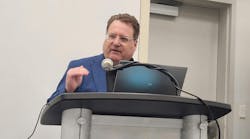5 Key Codes and Standards to Know for Fire System Inspection, Testing, and Maintenance (Southern California Facilities Expo 2025)
Will your critical fire protection—detection, alarm, and suppression systems—work when you need them to?
Inspection, testing, and maintenance schedules aren’t a suggestion—they’re in place to help you make sure the systems that are supposed to protect people and property are functioning all the time. These schedules are part of the standards developed by the National Fire Protection Association (NFPA) and referenced into the International Fire Code.
Many insurers require inspections per the NFPA standards, as do many jurisdictions, explained David Olds, business development manager and primary educator for FPS, a full-service integrator for fire alarm, detection, and suppression systems, in his Wednesday presentation at the 2025 Southern California Facilities Expo. Olds has over 30 years of experience in critical facility construction, with a focus on fire and life safety for the past 15 years.
Regular inspection, testing, and maintenance also helps minimize false alarms and system malfunctions.
“Who’s responsible to make sure this happens—that things are inspected, tested, and maintained?” Olds asked. “The buck stops at the owner, per the standard and local codes. Can they delegate that responsibility and often do? Absolutely. If you do delegate that, the authority having jurisdiction—whether that’s the fire marshal or a building official—is going to ask you to have a contract in writing to make sure that’s happening. It all comes back to the owner.”
NFPA has more than 300 standards, but five are key for most building owners and facility managers to become familiar with: 10, 25, 72, 101, and 2001. Each governs a different aspect of design and installation, as well as post-installation inspection, testing, and maintenance.
Inspection, Testing, and Maintenance: What’s the Difference?
NFPA lays out the difference between the inspection, testing, and maintenance steps. Inspections are mostly visual examinations, Olds explained. “You’re looking for that sprinkler or smoke detector that’s been blocked—things that are awry or damaged that should be there,” he said. “Those things can impair the operation of a system.”
For example, has the configuration of the room changed? Have there been any other physical changes that could impact system performance? Is all the equipment in good operating condition and free of physical damage?
Testing involves actually verifying that systems work. “It’s a hands-on activity, and it is disruptive,” Olds said. You’ll need to notify affected parties, from the building occupants to monitoring companies and even the fire department. “We don’t want to trip fire suppression when we’re testing the alarm, for instance,” Olds said. “It’s going to be noisy and disruptive. You want to have a good notification plan when testing is happening.”
Maintenance is triggered by the inspection or testing steps and requires you to repair any damaged equipment and get it back in working order. This could be as simple as replacing batteries, but in any case, the maintenance step can trigger alarms and cause disruption, so people need to be notified during this step too.
NFPA 10: Standard for Portable Fire Extinguishers
Exclusively governing portable extinguishers, NFPA 10 is where you’ll find all of the requirements for having your handheld fire extinguishers tagged by a certified inspector. The inspector will look for issues like:
- Location of the extinguisher cabinet
- Obstructions
- Corrosion
- Whether the gauge is functional and giving the right reading
- The location of the label and whether it’s been removed
- Pin operation
- The breakaway seal and whether a replacement is needed
- Inspection tags
“Check to see if the tag is in date—you’ll be surprised at how often they aren’t,” advised Olds. “Make sure they’re within date.”
NFPA 25: Standard for the Inspection, Testing, and Maintenance of Water-Based Fire Protection Systems
This guide to traditional water-based sprinklers coordinates closely with NFPA 72, which governs detection systems. Chapter 5 lays out the time period in which different tasks need to be done and who is qualified to do them. “This is handy if you’re looking at doing some of the inspection yourself,” Olds said.
For example, a weekly inspection could be done by your staff as they clean or security staff walking the building, Olds advised. “Look at gauges and make sure they’re operating,” he said. “Control valves should be in the proper position.”
These easy tasks don’t need to be documented under NFPA requirements. Quarterly inspections do require documentation. The annual inspection is where things get more serious and more documentation is necessary, Olds said. The annual inspection is likely to include items like:
- Are fire department connections secure? These hookups have covers protecting the location where the fire department connects to your building, and covers tend to go missing because they’re made of brass, Olds said. “People are collecting and ‘recycling’ them, and then what happens is we have spiders and other critters crawling into the pipe. That’s something to watch out for,” Olds said.
- Is signage easily visible? Make sure fire system-related signage, including the sign for fire department connections, is easy to see and not obscured by anything.
- Is there any corrosion, damage, or other issues requiring maintenance?
A licensed company is required to perform testing and maintenance of sprinkler systems.
NFPA 72: National Fire Alarm and Signaling Code
This is the governing code for both the installation and inspection of fire alarm and smoke alarm systems, including heat detection systems. Semiannual and annual inspections of these devices need to be done by licensed and certified professionals. You can sign an annual testing contract with companies that perform these services to make sure your system is being inspected, tested, and maintained on the required schedule. They’ll ensure your alarming system is functioning correctly by answering questions such as:
- Is an alarm displaying a trouble or supervisory alert? A trouble condition means something isn’t working properly—perhaps the detector is dirty and is reporting that back to the panel, Olds said. A supervisory condition could mean that a test valve is in the wrong position and isn’t working.
- Is there adequate power to the panel? Companies will check operation with just 120V power and with the battery backup to make sure both sources of power will function during an emergency.
- When were the batteries changed? Code requires a battery change every five years, but best practice is to change them every three years, Olds said. “The code is written to say from their date of manufacture, and we don’t know how long they sat on the shelf before they were installed in your facility,” Olds explained.
NFPA 101: Life Safety Code
This wide-ranging code covers many aspects of life safety, including means of egress. NFPA 101 states, “The purpose of this Code is to provide minimum requirements, with due regard to function, for the design, operation, and maintenance of buildings and structures for safety to life from fire. Its provisions will also aid life safety in similar emergencies.”
NFPA 2001: Clean Agent Fire Extinguishing Systems
Clean agent systems are used in certain applications, such as data centers or museums where there is fragile artwork. They detect fire at an earlier stage and suppress the fire with non-conductive, gaseous elements that are generally environmentally friendly.
Your staff can do monthly inspections if they obtain the proper training. “You’re looking at whether the controls are obstructed, there’s no physical damage, the pressure gauge, and whether things have been changed on the hazards,” Olds said. Changes to the room where the systems are installed is a major issue—gas systems can be sensitive to new holes in the room, Olds explained. You need to be able to hold the gas in the space until the fire department arrives. Manufacturers may talk about a 10-minute hold time, for instance.
The system also requires a semiannual inspection by a certified technician who has been trained on the equipment—that person will make sure the suppression agent is still in the cylinder. An annual inspection will examine the space and make sure there are no changes, especially to the volume of the space. If you’ve moved walls or your door closers aren’t in place anymore, that could create issues.
Ultimately, fire protection systems are only as effective as the attention given to their inspection, testing, and maintenance. While the codes and standards—particularly NFPA 10, 25, 72, 101, and 2001—provide a solid framework for compliance, the true responsibility rests with building owners and their designated teams. As Olds emphasized, delegating tasks does not mean delegating accountability. By understanding the requirements, scheduling regular checks, and working with qualified professionals, facility managers can ensure their systems are not only code-compliant but also ready to perform when lives and property are on the line.



